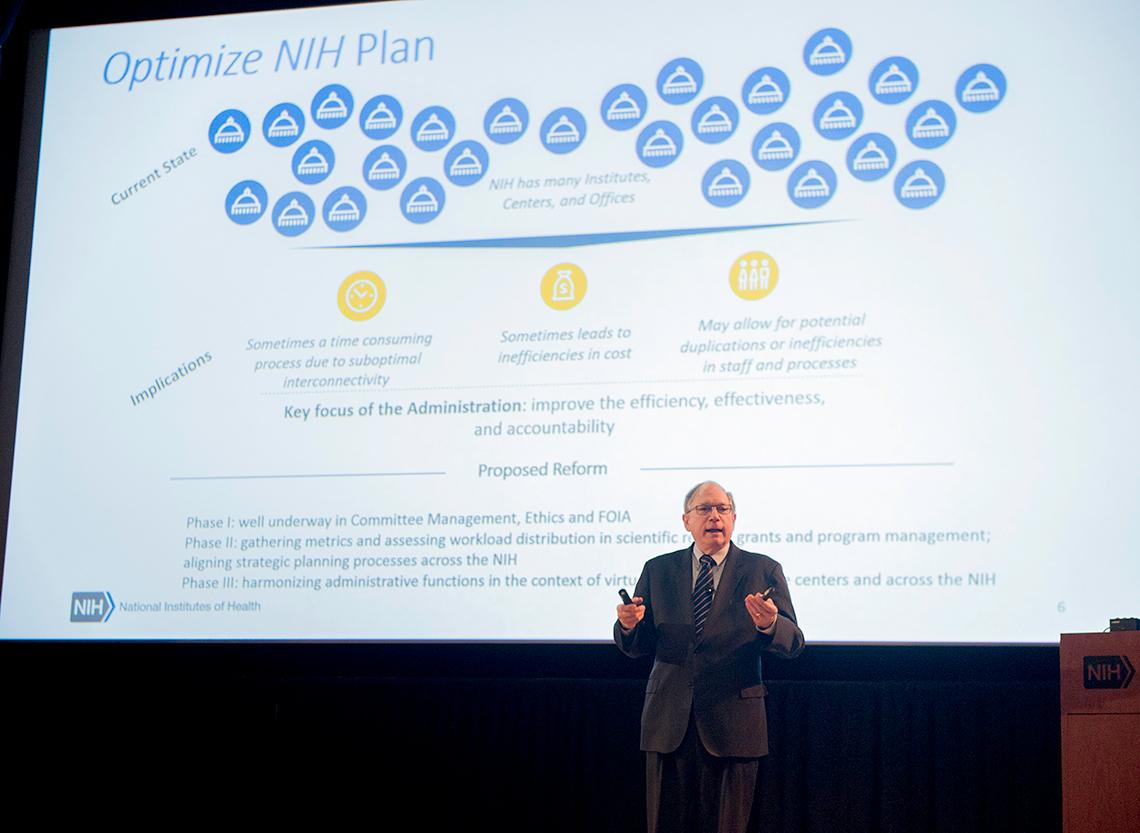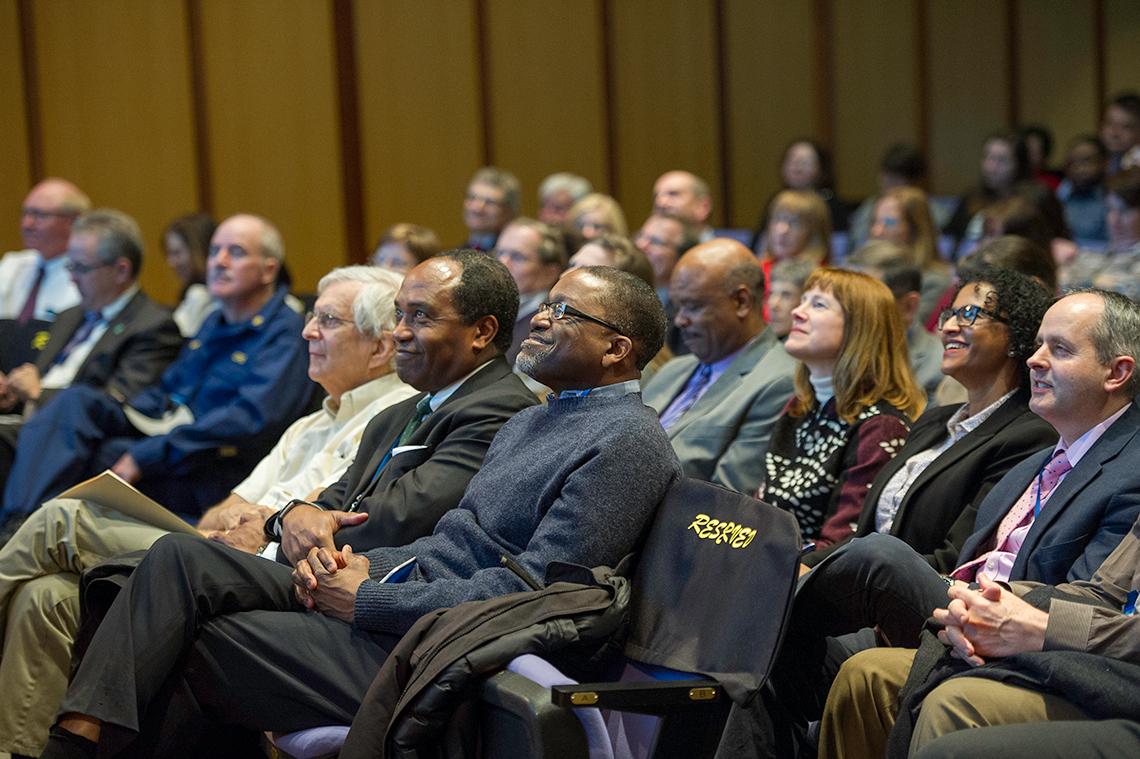Doing Business Better
Town Hall Updates Progress On ‘Optimize NIH’

Photo: Marleen Van Den Neste
At an NIH-wide town hall meeting on the effort to “Optimize NIH,” NIH principal deputy director Dr. Lawrence Tabak wanted to make one thing clear at the outset.
“There will be no reductions in force, so-called RIFs, as a result of this effort,” he said early and often throughout the hour-long event held Mar. 23 in Kirschstein Auditorium, Natcher Conference Center. “This is not about people losing jobs…Let’s put that out of play. That was the first principle we discussed with [HHS] as we’ve been working through all of this. The reason that was the first principle is because of how highly we value our workforce and how important all of you are to what we do here.”
Optimize is NIH’s response to the Department of Health and Human Services’ “Reimagine HHS” initiative to improve efficiency and effectiveness. HHS launched Reimagine in support of a directive from the Office of Management and Budget in early 2017 to make federal government “lean, accountable and more efficient.”
NIH, the HHS agency with the greatest number of employees in the department, took up the Reimagine challenge last December, in order to design its own strategy for finding ways to work better—to optimize. The town hall was held to give background on the department’s overall initiative and to describe NIH-specific work to date, plans for implementation and future phases.
Reimagine is organized into 10 teams working on 6 strategic shifts: putting people at the center of HHS programs, restoring market forces, leveraging the power of data, making HHS more innovative and responsive, generating efficiencies through streamlined processes and moving to a 21st century workforce.
NIH’ers are involved in 5 of the 10 teams, but driving only one—the one called “Optimize NIH,” which falls within the shift to make HHS more innovative and responsive.
“We were entrusted with the charge of coming up with a plan to improve efficiencies here at NIH,” Tabak pointed out. Among HHS agencies, only NIH and FDA were given such leeway to chart their own destinies at the operating division level. Tabak, along with NIH deputy director for management Dr. Alfred Johnson, leads Optimize.

Photo: Marleen Van Den Neste
“This is very much an NIH-developed and NIH-driven program,” Tabak said. “We’ve taken full advantage of this opportunity.”
Focusing on how NIH conducts its business functions, Optimize identified three areas—committee management, ethics and Freedom of Information Act (FOIA)—to review first in phase 1.
More than 110 designated representatives—and volunteers—from all three groups worked together on “process mapping,” which meant examining individual functions and procedures comprehensively, step by step to find potential redundancies and areas for possible collaboration or economies of scale.
“The current state of NIH is that we have many institutes, centers and offices,” Tabak said. “When you have seen one institute, you have seen one institute. There is virtually nothing that is the same in every institute. That’s part of our strength, but from an efficiency and an administrative viewpoint, that also is a potential weakness. The idea is to maximize the strength part of that diversity approach—by identifying the best way of doing things—and to minimize the inefficient part.”
Also already under way, phase 2 involves gathering metrics, assessing workload distribution and aligning NIH strategic plans.
In phase 3, which is set to start in 6-9 months, Optimize will harmonize administrative functions via virtual operational service centers. Informal conversations with executive officers, who are considered the domain experts for individual components, will begin immediately to get the lay of the land on how this phase can best be accomplished.
Tabak explained that, unlike the wide diversity of processes needed to address specific scientific areas, there may be functions that do not benefit from so many different approaches. “That’s what we’re going to focus on,” he said.
Optimize is expected to take 2-3 years to complete.
“We’re going to do this in a data-driven, deliberative, careful manner,” emphasized Tabak. “Rule one—no RIFs. Rule two—do no harm. The goal here is not to break anything. The goal here is to make things better, to enable you as our employees to enhance what you do so you can do a better job.”

Photo: Marleen Van Den Neste
A grid preliminarily developed by Optimize puts certain admin functions into seven virtual service centers in phase 3, so that NIH can benefit from enhanced collaboration and best practices. Tabak quickly put to rest the notion that NIH will collapse certain ICs or consolidate specific offices.
“We will not be consolidating anything,” he said. “We’re not preordaining any centralization in phase 3 other than we want the institutes and centers who are grouped together to be working more in harmony, trying to achieve any economies of scale that are possible.”
In the Q&As, Tabak addressed several topics, including how Optimize’s success will be measured, the possibility of offering buyouts and the current hiring process.
NIH’ers can watch the whole town hall online at https://videocast.nih.gov/summary.asp?Live=27411&bhcp=1. Also, an intranet site devoted to the effort will be updated regularly at http://employees.nih.gov/pages/optimize-nih.aspx.
